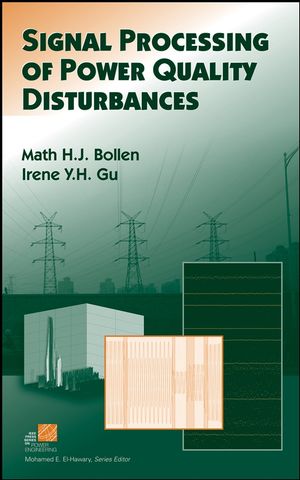Signal Processing of Power Quality DisturbancesISBN: 978-0-471-73168-9
Hardcover
861 pages
August 2006, Wiley-IEEE Press
 This is a Print-on-Demand title. It will be printed specifically to fill your order. Please allow an additional 15-20 days delivery time. The book is not returnable.
|
||||||
ACKNOWLEDGMENTS.
1 INTRODUCTION.
1.1 Modern View of Power Systems.
1.2 Power Quality.
1.3 Signal Processing and Power Quality.
1.4 Electromagnetic Compatibility Standards.
1.5 Overview of Power Quality Standards.
1.6 Compatibility Between Equipment and Supply.
1.7 Distributed Generation.
1.8 Conclusions.
1.9 About This Book.
2 ORIGIN OF POWER QUALITY VARIATIONS.
2.1 Voltage Frequency Variations.
2.2 Voltage Magnitude Variations.
2.3 Voltage Unbalance.
2.4 Voltage Fluctuations and Light Flicker.
2.5 Waveform Distortion.
2.6 Summary and Conclusions.
3 PROCESSING OF STATIONARY SIGNALS.
3.1 Overview of Methods.
3.2 Parameters That Characterize Variations.
3.3 Power Quality Indices.
3.4 Frequency-Domain Analysis and Signal Transformation.
3.5 Estimation of Harmonics and Interharmonics.
3.6 Estimation of Broadband Spectrum.
3.7 Summary and Conclusions.
3.8 Further Reading.
4 PROCESSING OF NONSTATIONARY SIGNALS.
4.1 Overview of Some Nonstationary Power Quality Data Analysis Methods.
4.2 Discrete STFT for Analyzing Time-Evolving Signal Components.
4.3 Discrete Wavelet Transforms for Time–Scale Analysis of Disturbances.
4.4 Block-Based Modeling.
4.5 Models Directly Applicable to Nonstationary Data.
4.6 Summary and Conclusion.
4.7 Further Reading.
5 STATISTICS OF VARIATIONS.
5.1 From Features to System Indices.
5.2 Time Aggregation.
5.3 Characteristics Versus Time.
5.4 Site Indices.
5.5 System Indices.
5.6 Power Quality Objectives.
5.7 Summary and Conclusions.
6 ORIGIN OF POWER QUALITY EVENTS.
6.1 Interruptions.
6.2 Voltage Dips.
6.3 Transients.
6.4 Summary and Conclusions.
7 TRIGGERING AND SEGMENTATION.
7.1 Overview of Existing Methods.
7.2 Basic Concepts of Triggering and Segmentation.
7.3 Triggering Methods.
7.4 Segmentation.
7.5 Summary and Conclusions.
8 CHARACTERIZATION OF POWER QUALITY EVENTS.
8.1 Voltage Magnitude Versus Time.
8.2 Phase Angle Versus Time.
8.3 Three-Phase Characteristics Versus Time.
8.4 Distortion During Event.
8.5 Single-Event Indices: Interruptions.
8.6 Single-Event Indices: Voltage Dips.
8.7 Single-Event Indices: Voltage Swells.
8.8 Single-Event Indices Based on Three-Phase Characteristics.
8.9 Additional Information from Dips and Interruptions.
8.10 Transients.
8.11 Summary and Conclusions.
9 EVENT CLASSIFICATION.
9.1 Overview of Machine Data Learning Methods for Event Classification.
9.2 Typical Steps Used in Classification System.
9.3 Learning Machines Using Linear Discriminants.
9.4 Learning and Classification Using Probability Distributions.
9.5 Learning and Classification Using Artificial Neural
Networks.
9.6 Learning and Classification Using Support Vector Machines.
9.7 Rule-Based Expert Systems for Classification of Power System Events.
9.8 Summary and Conclusions.
10 EVENT STATISTICS.
10.1 Interruptions.
10.2 Voltage Dips: Site Indices.
10.3 Voltage Dips: Time Aggregation.
10.4 Voltage Dips: System Indices.
10.5 Summary and Conclusions.
11 CONCLUSIONS.
11.1 Events and Variations.
11.2 Power Quality Variations.
11.3 Power Quality Events.
11.4 Itemization of Power Quality.
11.5 Signal-Processing Needs.
APPENDIX A IEC STANDARDS ON POWER QUALITY.
APPENDIX B IEEE STANDARDS ON POWER QUALITY.
BIBLIOGRAPHY.
INDEX.



